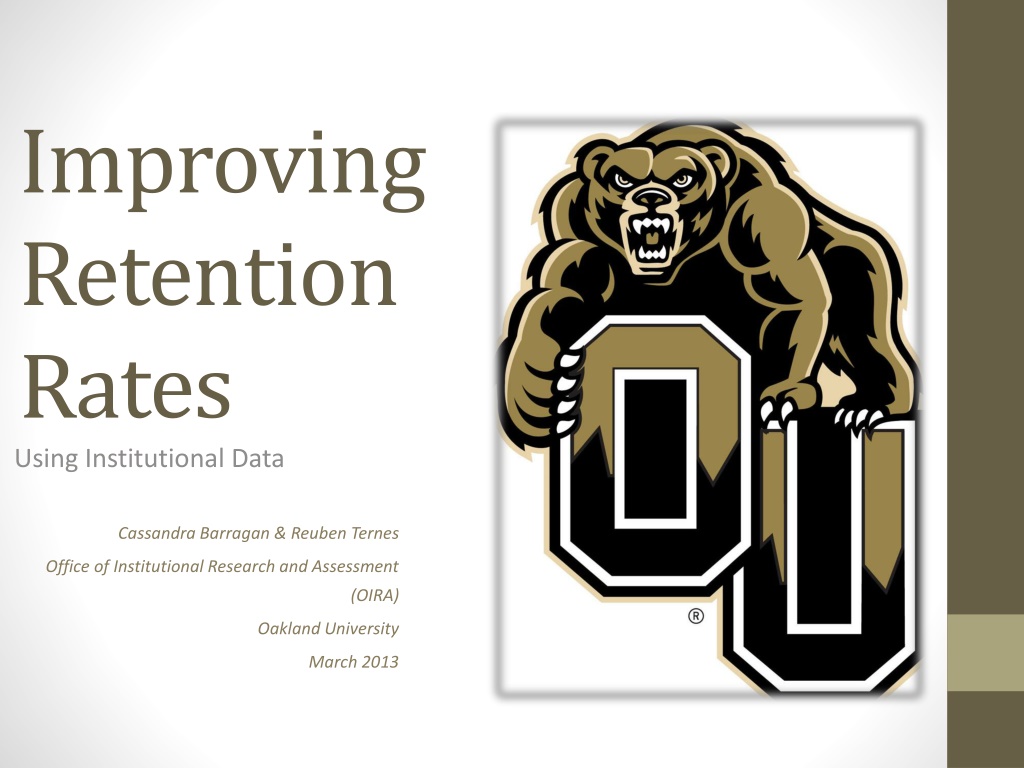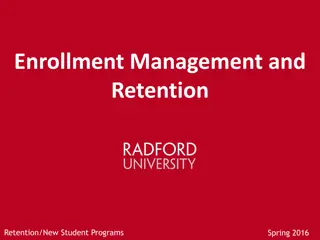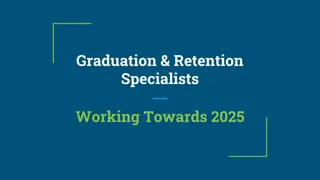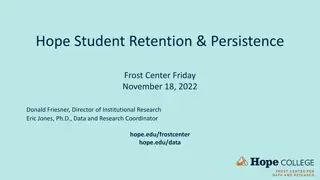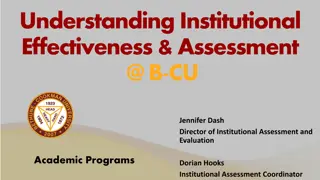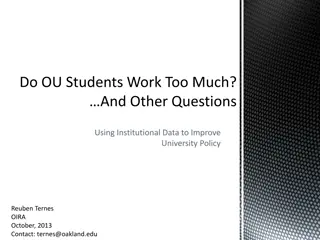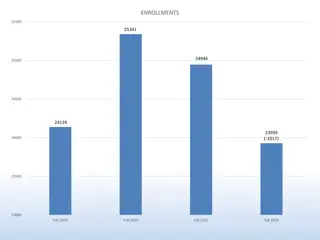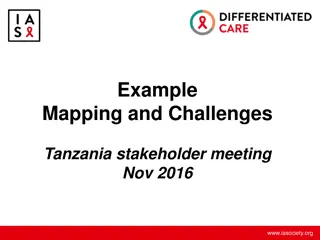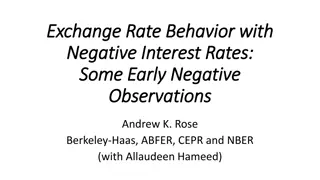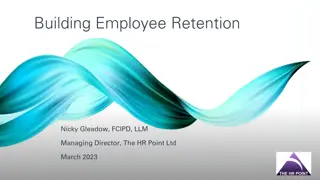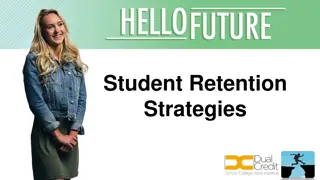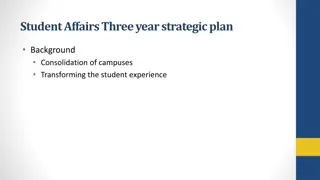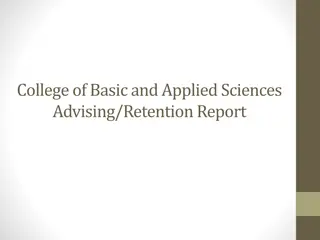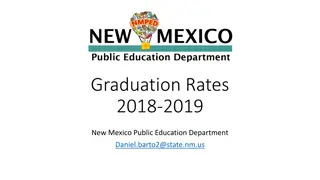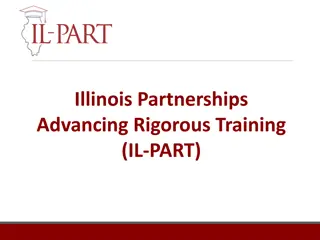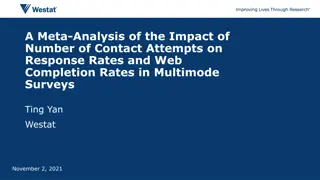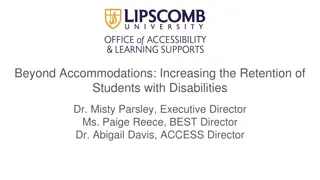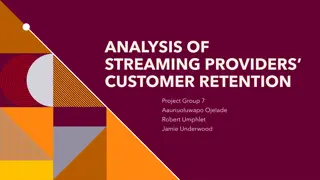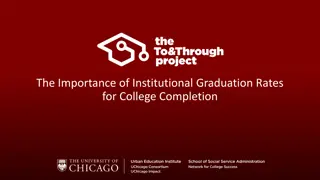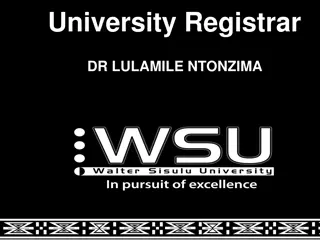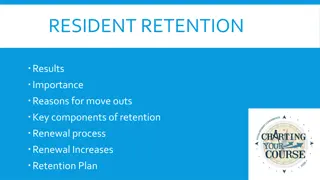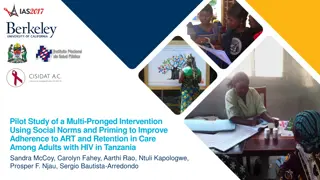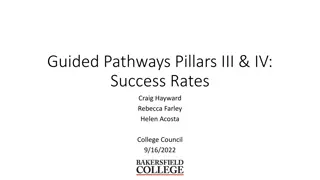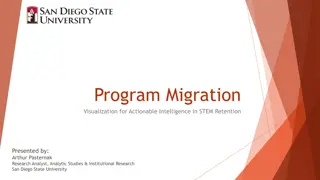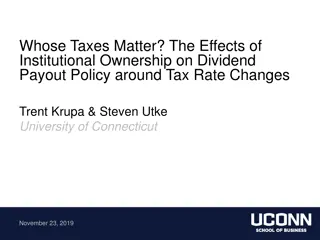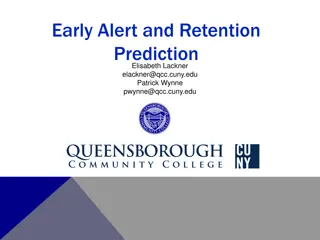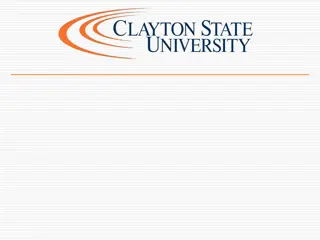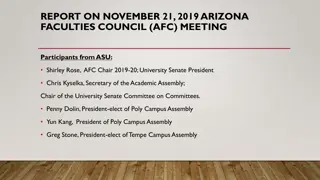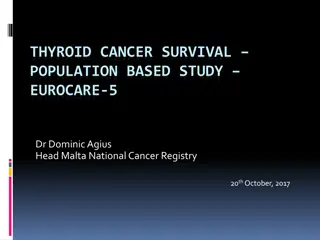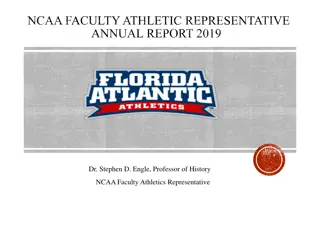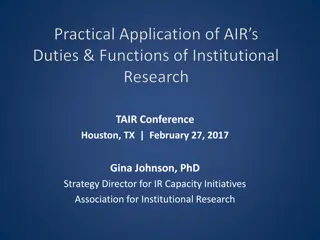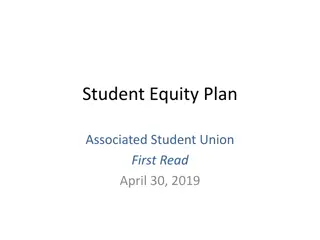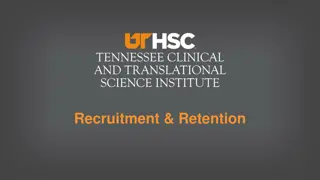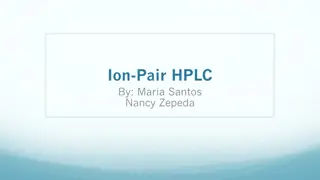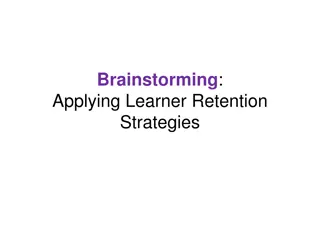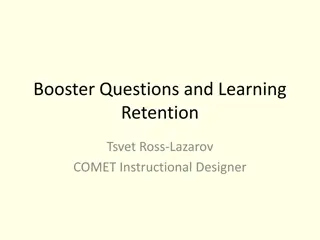Enhancing Student Retention Rates through Institutional Data Analysis
Explore how Oakland University's Office of Institutional Research and Assessment leverages various data sources, policy analysis, and predictive modeling to improve student success and retention. Discover the role of IR offices, available resources, survey data, and the importance of collaboration for enhancing institutional effectiveness.
Download Presentation

Please find below an Image/Link to download the presentation.
The content on the website is provided AS IS for your information and personal use only. It may not be sold, licensed, or shared on other websites without obtaining consent from the author. Download presentation by click this link. If you encounter any issues during the download, it is possible that the publisher has removed the file from their server.
E N D
Presentation Transcript
Improving Retention Rates Using Institutional Data Cassandra Barragan & Reuben Ternes Office of Institutional Research and Assessment (OIRA) Oakland University March 2013
Presentation Outline Introduction to OIRA Section I: Sources of data Surveys University Section II: Policy Analysis Section III: Predictive Modeling
Session Goals Why are we giving this presentation? Answer: Many institutions have a vibrant and robust institutional research office that do all kinds of really neat research about students and student retention. Our goal is to familiarize you with the types of resources that you may already have at your campus Partnering with your IR office can be a valuable way to boost your efforts to improve student success and retention!
Introduction to OIRA About OIRA The Office of Institutional Research and Assessment (OIRA) supports the planning, decision-making and self-assessment activities of the university community by providing and coordinating information about the progress of OU s efforts to continuously improve itself. Most institutions have an IR office Other Names for IR offices: Budget & Planning, Institutional Effectiveness, Institutional Assessment, etc. We fill out external surveys, conduct original research, organize internal surveys, report official statistics, and are otherwise responsible for producing a host of different institutional data for the consumption of the university.
What Data is on our Website? Enrollment Data Degrees Awarded Information about the Assessment of Student Learning National Student Survey Results Research on OU Students Comparative Departmental Information Presentations Historical trend data Faculty numbers And much more .
Surveys Internal Surveys Committees, etc.
IRB approved protocol through Indiana University Bloomington Survey instrument: http://nsse.iub.edu/pdf/survey_instruments/2013/2013%20NSSE%20I nstrument.pdf Results : NSSE Results: http://nsse.iub.edu/html/reports.cfm Predictive Validity for retention Level of Academic Challenge (LAC) significant for # credit hours earned Student Faculty Interaction (SFI) - # credit hours & persistence Supportive Campus Environment (SCE) Deep Approaches to Learning (DAL) Reliability Measuring of concepts & constructs internal consistency Stability over time & repeat administration Generalizable
Areas Measured by The area of Academic Challenge includes four areas Higher-Order Learning, Reflective and Integrative Learning, Quantitative Reasoning, and Learning Strategies. Higher-Order Learning How much courses emphasize advanced thinking skills such as applying theories to practical problems or synthesizing information into new interpretations Higher-Order Learning ( 2004 = .82, 2005 = .82) HL1 Analyzed the basic elements of an idea, experience, or theory, such as examining a particular case or situation in depth and considering its components HL2 Synthesized and organized ideas, information, or experiences into new, more complex interpretations and relationships HL3 Made judgments about the value of information, arguments, or methods, such as examining how others gathered and interpreted data and assessing the soundness of their conclusions HL4 Applied theories or concepts to practical problems or in new situations
Established behaviors in high school; Academic preparedness; Admissions decisions; Expectations of college; Interactions with peers and faculty; Student values and goals and Student demographic characteristics; and Concerns about financing college. Psychometrics & Constructs: http://www.heri.ucla.edu/PDFs/constructs/technicalreport.pdf http://www.heri.ucla.edu/constructfaq.php
University Departments Student Affairs Student group involvement Learning community & housing Registrar s Office (Academic Affairs) Class information Credit hours College and Major Demographics Grades Much of it pulled from Banner (OU s ERP system) Financial Aid Scholarships Financial aid offers
Combining Data Study habits Personal beliefs Plans for the future Engagement in the educational process Sense of satisfaction Sense of campus community Social environment Faculty/staff involvement Known predictors of retention Examine policies Longitudinal trends Putting a face to the numbers what does your student body look like? Data is at aggregate & student level
Finding the data that fits your needs Researchers What populations are on your campus? Educators Can learn more about your students to tailor their education experience to be as relevant as possible Administrators Tell me about our students. What are they telling us & what can we learn from them? But it should be granular enough to have meaning to individuals! Data needs to be actionable. (The retention rate for biology students means more to the biology department than the retention rates for all students)
Policy Analysis How do you know you are meeting goals and benchmarks? How do you know that university policies aimed at improving the student experience are working? Do they impact retention? What hurts retention efforts? Where is the biggest bang for your buck ?
Examples 1. Advising Policies Data from internal university records ACT scores Enrollment/retention information Number of credits 2. Financial Aid & Retention Data from internal university records ACT scores Enrollment/retention information Number of credits
Example 1: Advising Policies Should we recommend that students take smaller class loads if they have lower ACT scores? Rationale: We don t want to overload students that might not be academically underprepared. What does the data say? Retention rates do drop as ACT scores decline. But the decline is small. The data also show that the more credits a student takes, the more likely they are to be retained. The data isn t causative, its correlational. However, there just isn t any data to support the overload theory.
Augmenting University Data You can get a good picture about retention through university data, but other sources may help to understand the why . Advising policy findings: Students with more credits and higher ACT scores have higher retention rates but those with higher ACT scores and lower credits have a lower retention rate. Question: Why is the retention rate low even for those with high ACT scores Is there something in the demographic profile? Personality profile? Reasons to attend?
Example 2: Financial Aid Policy In order to qualify for our large institutional grants you must have an ACT score of a 21 or higher. Must demonstrate need The grant size is usually substantial (several thousand dollars). What is the impact of our need-based aid on student retention? Can we get at a causative answer instead of just correlational?
Getting to causality We can get at a causative answer by using a regression discontinuity framework. Basically, we graph things and look at the relationship right near the area where things are similar in criteria, but have vastly different in experience. For us, we will look at students just below the cut-off score (ACT 21). These students are similar to those just above them. But have vastly different experiences.
The Dashed Lines The dashed lines represent students that have not demonstrated financial need. They are separated into two groups, those with ACT scores 21 and above. And those with scores below a 21. Notice that there is NO gap, or discontinuity between the two groups. The two dashed lines could be represented by the same color and you would never be able to tell where the discontinuity was.
The Solid Lines The Red line (on the left) represents students with ACT scores of less than a 21. These students did not qualify for a large portion of OU s need- based aid. The Black solid line (on the right) represents students with ACT scores of a 21 or more. These students potentially qualify for additional need-based aid. Notice the HUGE gap between the red and black lines. This gap is causative evidence that need based aid had a positive impact on the retention of students near the cut-off.
Risk Factors & Retention One of the easiest ways to model retention is to categorize students into risk factors First Generation Minority Status Low Incoming Preparation (ACT/HS GPA) Pell Eligible Etc. Then count the number of risk factors for each student. Use historical data to forecast new years. Generally, the model is very good at the aggregate level. But it s still pretty crude.
Regression Alternatively, IR researchers can use regression Improved flexibility Can include as many or as few variables as you d like Can build interactions Increased sophistication (not all variables are equally important) In theory, provides a more reliable retention probability for each student. In practice, sometimes it does, sometimes it doesn t. Regression also has some inherent weaknesses such as: over-fitting of data categorical variable issues
Machine Learning Algorithms A host of relatively new predictive tools are just becoming popular. Including various machine learning algorithms (MLAs) These algorithms have several advantages over regression Have procedures to estimate missing data well Can reduce the amount of over-fitting Some MLAs are really easy to use Can handle hundreds of different variables Categorical (i.e. non-numerical) data is OK Many do not make any assumptions at all non-parametric Overall good performance relative to most regression methods
An Example MLA Random Forest Q: What is Random Forest? A: A tool that makes really good predictions Q: How does it work? A: It builds lots of (decision) trees Randomly (That s why it s called Random Forest)
Advantages & Disadvantages Advantages Deals with missing data well Robust to over-fitting Relatively easy to use Can handle hundreds of different variables Categorical (i.e. non-numerical) data is OK Makes no assumptions (non-parametric) Overall good performance Disadvantages Probability values are the only statistics generated List of variables in order of importance, but without statistics to draw your own conclusions For more information about random forest methods: http://www.miair.org/web_documents/using_random_forest_101.pptx
Improving Retention Rates Using Institutional Data A. Introduction to OIRA Cassandra Barragan Barragan@oakland.edu Reuben Ternes B. Section I: Sources of data ternes@oakland.edu Office of Institutional Surveys Research and Assessment (OIRA) www.oakland.edu/OIRA University Oakland University March 2013 C. Section II: Policy Analysis D. Section III: Predictive Modeling For a copy of this presentation: http://www.oakland.edu/?id=14323&sid=250
